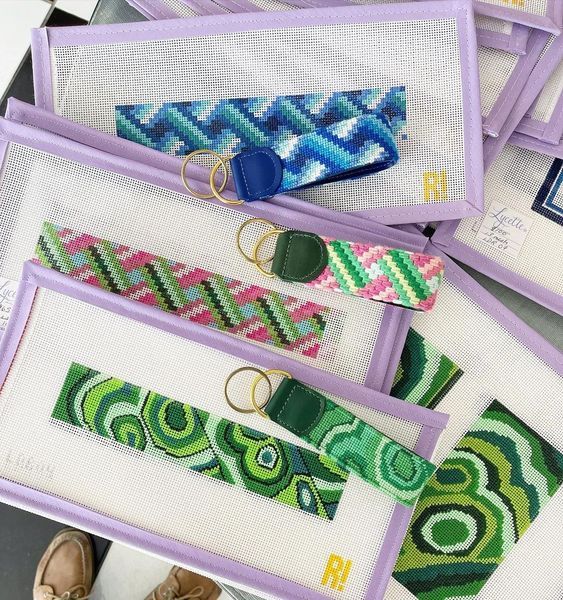Needlepoint is not just a hobby, but an artistic expression that allows stitchers to create intricate, textured, and visually stunning pieces. Among the myriad of techniques available, decorative needlepoint stitches provide a unique opportunity to elevate any needlepoint project. Lycette Designs offers a range of resources from hand-painted canvases to luxury threads to needlepoint classes to help both beginners and seasoned crafters master these advanced techniques. This guide explores the various types of decorative stitches and how you can learn these techniques through comprehensive classes.
7 Types of Popular Decorative Needlepoint Stitches
Once you’ve practiced basic stitches, test your capabilities with decorative stitches. Whether you're looking to add depth, dimension, or a touch of flair, these stitches are perfect for enhancing your needlepoint projects. Get ready to broaden your stitching repertoire and bring a new level of beauty to your canvases with these popular methods:
1. Bamboo Stitch:
The Bamboo Stitch is a decorative needlepoint stitch that mimics the look of bamboo stalks. It consists of vertical columns made up of alternating long and short stitches that create a textured pattern reminiscent of bamboo's jointed stalks. This stitch is excellent for adding a natural, organic feel to your projects, particularly in designs where you want to evoke a sense of nature or tranquility. It works well on a variety of canvases and can be used as a filler or a thematic accent in botanical designs.

2. Herringbone Stitch:
The Herringbone Stitch features a distinctive V-shaped weaving pattern that can be adjusted in width and length to suit different design needs. It's particularly effective for borders or as a filling stitch with a textured, interlaced appearance that adds depth to any needlepoint project.
3. Parisian Stitch:
The Parisian Stitch is a simple yet elegant needlepoint stitch. It involves a basic straight stitch that alternates direction row by row, creating a fine, mesh-like texture. This stitch covers the canvas quickly and provides a smooth finish that is less bulky than other stitches, making it ideal for backgrounds or for giving your work a delicate, airy feel. The Parisian Stitch is especially popular for its ease of execution and versatility, fitting well into both modern and traditional designs.

4. Double Hungarian Stitch
The Double Hungarian Stitch is an advanced variation of the basic Hungarian Stitch. It involves two sets of vertical stitches that cross over each other, forming a dense and textured pattern. This stitch is particularly effective for filling larger areas as it provides substantial coverage and adds depth to the needlepoint work. The Double Hungarian Stitch is visually striking and can serve as a focal point in any design, offering a rich texture and intricate appearance.

5. Criss Cross Hungarian Stitch
The Criss Cross Hungarian Stitch is a complex stitch that builds on the traditional Hungarian stitch by adding an additional layer of crisscrossing stitches. This results in a highly textured and robust pattern that stands out on the canvas. It is perfect for projects where you want to add a touch of sophistication and complexity. The crisscross pattern not only enhances the visual appeal but also gives a tactile richness to the work, making it ideal for decorative elements in pillows or wall hangings.

6. Wave Stitch
The Wave Stitch is a dynamic and fluid stitch that creates a wavy, flowing effect on the canvas. This stitch involves a series of sweeping curves that mimic the movement of waves. It’s an excellent choice for depicting water, skies, or even abstract designs that require motion. The Wave Stitch can be varied in length and amplitude to adjust the wave’s intensity, making it a versatile tool in a needle pointer's repertoire. It adds movement and life to any piece, offering a sense of rhythm and flow that can elevate a simple design to something truly special.

6. Byzantine Stitch:
A Byzantine Stitch is a sequence of overlapping diagonal stitches that form a detailed and textured pattern. It's a versatile stitch that works well for covering larger areas while providing a luxurious, woven look that enhances the overall complexity of the needlepoint work.

7. Jessica Stitch:
Jessica Stitch involves creating a series of looped stitches that can be arranged to form circles, ovals, or other shapes. This stitch is fantastic for crafting decorative elements that stand out, such as flowers, baubles, or other rounded motifs, giving them a sculpted appearance.
Each of these decorative stitches can enhance a needlepoint project by adding texture, depth, and visual interest, making them valuable tools for both beginners looking to expand their skills and experienced stitchers seeking to incorporate intricate details into their work.
How to Choose Decorative Needlepoint Stitches for Different Projects:
Based on the search results, here are some key tips for choosing the right decorative needlepoint stitch for a specific project:
- Look for stitches that complement the overall design and aesthetic you're going for.
- Decorative stitches can be used to add texture, visual interest, or to highlight certain design elements.
-
Choose stitches that work well for the intended use of the project, whether it's a background, border, or focal point.
- For first-time use of decorative stitches, the sources recommend starting with easier options like mosaic, brick, or Scotch stitches. These provide a good introduction to decorative stitching without being overly complex.
- Use a blank "doodle canvas" to practice new stitches before committing them to your final project.
-
This allows you to get a feel for the stitch and see how it looks without the risk of mistakes.
- Match the stitch to the canvas mesh size - larger stitches work better on lower mesh counts.
-
Choose threads that complement the stitch, such as textured or variegated threads for more decorative effects.
- Stitches can be worked vertically, horizontally, or diagonally to create different visual effects.
- Placing decorative stitches in open areas or as accents can make them stand out.
The key is to experiment, consider the project needs, and start simply as you incorporate decorative needlepoint stitches into your work.
Approaches to Learning Decorative Stitches: Methods from Lycette Designs
Exploring decorative needlepoint stitches can transform your projects from simple to spectacular. Lycette Designs offers several effective approaches to learning these advanced techniques, ensuring there's a method that fits every learner's style and availability.
-
Lycette Designs Pinterest Board and Stitch Books
For those who prefer to learn at their own pace, Lycette Designs provides extensive resources online. Their Pinterest board is rich with visual inspirations and practical tips, perfect for needlepoint enthusiasts. Additionally, detailed stitch guides are available on our website, offering step-by-step instructions on how to execute each decorative stitch. These resources allow you to practice and perfect new stitches in the comfort of your home.
-
In-Person Workshops: Lycette Designs Offers Classes for First-Hand Experience
If you thrive in a structured learning environment, Lycette Designs' in-person workshops are an ideal choice. These classes offer first-hand experience with direct guidance from skilled instructors. You'll get immediate feedback and tips, enhancing your stitching technique and ensuring you grasp the subtleties of each decorative stitch. These workshops are also a great opportunity to meet and interact with fellow needlepoint enthusiasts.
Needlepoint Classes Near Me—The Lycette Designs Experience
If you’re located in South Florida and searching for “needlepoint classes near me” Lycette Designs is your go-to resource. Whether you want needlepoint classes or just needlepoint stitch guides, there is a resource for every needle pointer!
Our classes fill up quickly, so don’t wait to join! This hands-on experience with professional needlepoint artists offers experiences that you won’t get anywhere else. If you’re unable to attend a class, consider our stitch books!
Materials Needed for Decorative Stitches
The right materials can make a significant difference in the execution and appearance of decorative stitches. Here’s what you generally need:
- Specialty Threads: Silk, metallic, or overdyed fibers can add a unique touch to your work.
- Variety of Needles: Different sizes and types of needles may be required depending on the texture and weight of the thread.
- Sturdy Canvas: A good quality canvas that can hold up to the density of decorative stitches is crucial.
- Reference Guides: Stitch dictionaries and guides are useful for learning new patterns and techniques.
Start Decorating with Your New Skills
Mastering decorative needlepoint stitches opens up a world of possibilities for personalizing your needlepoint projects with stunning textures and intricate patterns. Lycette Designs is committed to supporting your journey through expertly led classes, detailed instructional guides, and a welcoming community of needlepointers.
Whether you are local or online, we invite you to join our needlepoint classes near me to enhance your skills, gain new insights from our blogs, and browse our extensive inventory. Visit Lycette Designs today to start your adventure in the artful world of decorative needlepoint stitches. Happy stitching!


Leave a comment